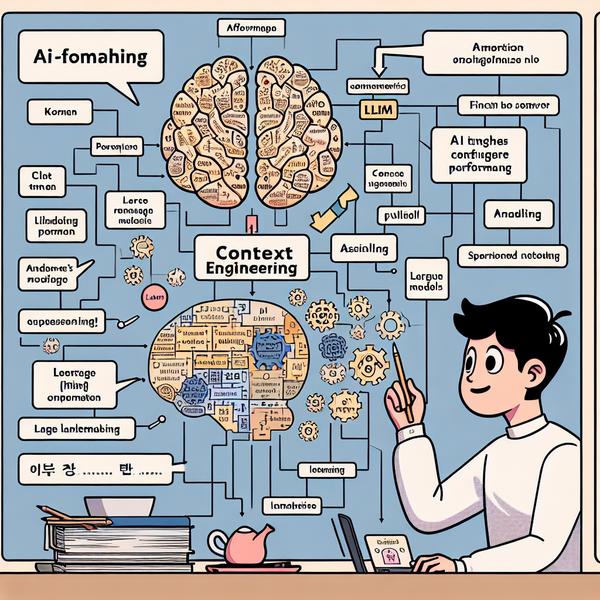
If you've always been fascinated by how artificial intelligence (AI) tools understand and respond to complex instructions, then you're not alone. The cutting-edge discipline of Context Engineering takes it one step further. Unlike simple prompt engineering, Context Engineering is a systematic framework for organizing and optimizing the information fed into Large Language Models (LLMs) for better performance. Think of it as fine-tuning the "brain" of an AI to make it sharper, quicker, and more reliable for real-world scenarios. The following sections will explore its key components, real-world impact, and future possibilities.
What Makes Context Engineering Revolutionary?
- Imagine trying to build a puzzle without knowing what the full picture looks like. This is what most AI systems face without proper context. Context Engineering, on the other hand, assembles information like precise puzzle pieces.
- Instead of treating context as just a static input string, it organizes the data dynamically using specific rules for selection, retrieval, and structuring.
- A concept highlighted in the "CLEAR Framework" involves assembling templates and modular architectures to strategically decide what makes it into the final AI input.
- By layering techniques like knowledge graphs and Retrieval-Augmented Generation (RAG), Context Engineering ensures AI systems can reference external sources in real-time, just like Googling something during a quiz.
- This approach reduces errors and boosts adaptability by ensuring the AI sees not just a needle, but the entire haystack if needed to draw accurate conclusions.
Breaking Down the Taxonomy of Components
- Three core pillars support Context Engineering: Retrieval and Generation, Processing, and Management. Think of them as the research, optimization, and storage wings of an AI brain!
- Retrieval and Generation: This includes methods like "Graph-of-Thought," which helps the AI process tasks in a networked, logical format, much like a detective piecing clues together. Another fun example is "Chain-of-Thought," mimicking human reasoning step-by-step.
- Processing: Systems like FlashAttention handle large texts efficiently, much like compressing a lengthy Netflix series into key moments without losing the story.
- Context Management: Systems like MemoryBank or MemGPT enable long-term adaptability. For example, AI that can store past decisions helps personal assistants recall preferences from months or even years back.
- Every element is specifically designed to optimize computation and make AI smarter without requiring endless hardware upgrades—a win-win for users and developers.
Applications That Are Changing the World
- From personal AI assistants that truly "know you" to multi-agent business problem-solvers, the applications of Context Engineering are breathtaking.
- Consider the potential for medical diagnostics. AI systems using structured memory can guide doctors through rare disease cases by checking similar historical data or referencing medical journals instantly.
- In education, AI-powered collaboration tools can assign different "agents" specialized tasks. For instance, one AI explains a math problem step-by-step while another monitors for misconceptions in real-time.
- Imagine a chatbot that reads all your favorite books and recalls details—a dream come true for authors, scholars, and even casual readers!
- Enterprises are already leveraging these tools for dynamic data analysis, project management, and enhanced customer service that adapts uniquely to each user query.
Challenges and Key Research Gaps
- Much like a talented student who struggles with articulation, even advanced AI systems sometimes fail to generate complexity that matches their understanding. This "Comprehension–Generation Asymmetry" is a current hurdle.
- Metrics like BLEU and ROUGE, which evaluate AI outputs, are outdated and don't measure layered reasoning or collaboration effectively. Imagine grading an essay only by word count! New benchmarks are in development to fix this.
- Context Engineering also faces scalability issues due to computational costs. The goal? Smarter handling of power-hungry systems through optimized attention mechanisms like LongNet.
- What about combining all senses into one conversation? Multi-modal AI hopes to integrate text, visuals, and even audio, taking information-rich fields like journalism or law to all-new heights.
- Lastly, ethical concerns, especially data privacy and alignment with public values, remain an essential area of focus for researchers to get right.
Future Directions: What Lies Ahead?
- Getting AI and humans to work harmoniously is the ultimate mission of Context Engineering. Researchers are exploring "Unified Theories" to mathematically define the best ways to design dynamic systems and their memory hierarchies.
- Closer integration with frameworks like open-source Python libraries (such as those Google has proposed) will democratize these technologies, allowing small startups to build their AI solutions cost-effectively.
- Long-term simulation tools will allow AI agents, like MemGPT, to "live" through experiences for personalized applications or research-intensive tasks.
- Cooperative multi-agent systems, where AI representations of individuals collaborate in teams, might soon become the backbone of major industries like finance or urban planning.
- Finally, ensuring LLMs understand ethical responsibilities—like avoiding biases and acting transparently—will form the foundation for AI regulations in the decade ahead.
Conclusion
Context Engineering is a transformative field that reshapes how AI understands and interacts with the world. By focusing on dynamic data optimization, scalable architectures, and ethical transparency, it paves the way for smarter, more human-like systems. Whether for education, healthcare, or customer service, its potential applications can revolutionize industries from the ground up. As research bridges gaps in metrics and scalability, Context Engineering could be the key to unlocking a truly intelligent digital future.